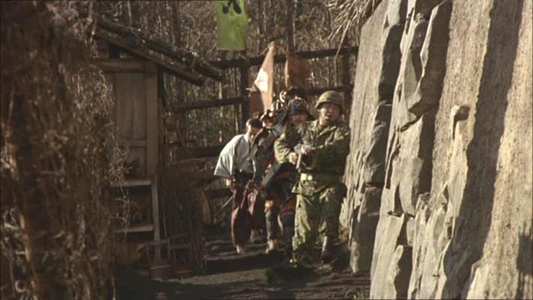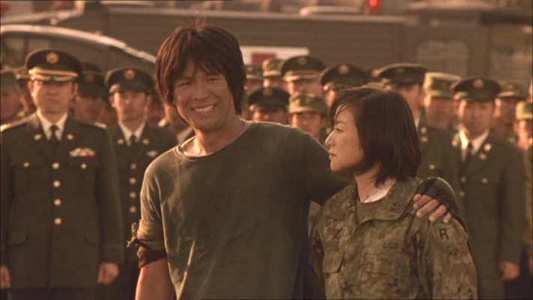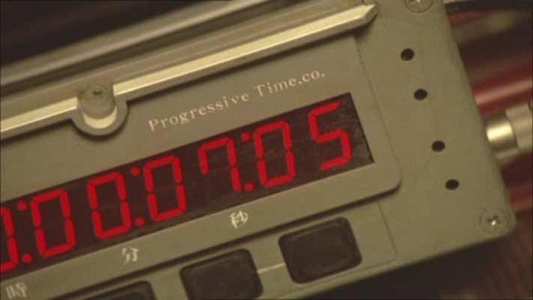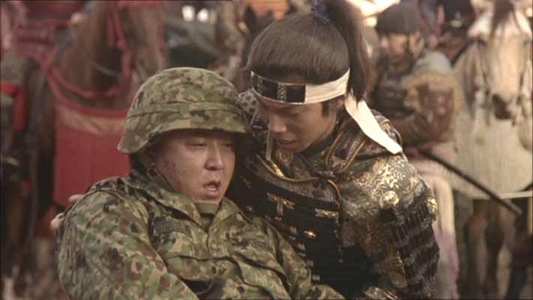Review of Samurai Commando
Introduction
I have a fondness for time travel movies, and movies that see the militaries of two different eras clash have a certain geek appeal for me. I admit to a probably misplaced fondness for Biggles, just for the sight of a helicopter going up against a biplane, and somewhat more satisfying are films like The Final Countdown, which sees the crew of a nuclear powered aircraft carrier getting the chance to avert Pearl Harbour, and The Philadelphia Experiment, which just tantalises my inner conspiracy theorist. Samurai Commando: Mission 1549 on the surface appears to be a cross between these two films, but it turns out that it`s a remake of sorts of the earlier 1979 Sonny Chiba film Samurai GI, both movies based on a novel by Ryo Hanmura. This time around, the SDF collaborated with the filmmakers to give a greater sense of realism.
I was going to recap the plot here, but looking above this review, I see a lengthy précis doing just that, in more detail than even I usually go into, so I`ll skip ahead to the meat of the criticism this time around. (And no, that isn`t Darth Vader on the cover)

Video
Samurai Commando gets a 1.85:1 anamorphic transfer that is adequate. Colours are a tad muted; the image is soft, grainy, but otherwise clear. There are some nice action sequences in this film, and the sight of tanks going up against warriors mounted on horseback appeals to the inner geek that I mentioned earlier. However the film is marred by some absolutely atrocious CGI. There are computer graphics in this film that wouldn`t have made the grade in a console game cut-scene seven years ago.

Audio
You get a choice of DD 5.1 or DTS Japanese with English subtitles. The sound is clear, and the surrounds are put to good use conveying the action sequences. The layer change is awful though. There was a time when companies used to make an effort to find a static and silent moment in which to put the layer switch. The Matrix is a perfect example of an invisible layer change. Nowadays, it`s as if companies have just given up. Here the layer change is 5 minutes from the end of the film, and you can watch the action pause and music stop while it happens.

Features
Unskippable piracy ad, animated menus, theatrical trailer, all pretty much standard with a DVD release nowadays. Fortunately there are some other extras, but they are eclectic at best.
Perhaps the most useless featurette I have ever seen is the first one, The Cast Greeting: Screening. This lasts 20 minutes but it isn`t, as you would expect a glimpse of the movie`s premiere. No, this goes behind the scenes of the premiere, to see how the SDF participated. You get to see the SDF at work, preparing for the long drive to Roppongi Hills in Tokyo, planning their route, accepting their orders, getting lost, worrying about the rush hour, and finally, the difficulty of driving their APCs through the theatrical smoke at the event. Dull, interminable and pointless.
More fulfilling is the Interview with Cast, which lasts 10 minutes as the cast talk about their characters and the movie.
Interview with Director lasts 13 minutes, and sees him interviewed along with the representative of the SDF who cooperated with the making of the film. They talk about the process of collaboration, and the sense of realism the joint venture precipitated.
Finally is the mislabelled Interview with Author. This isn`t actually a talk with Ryo Hanmura, but is actually a 25-minute chat with Fukui Harutoshi, the screenwriter who adapted the book to the screen. He talks about the approach to the new film, and why the continuity of the Sonny Chiba film had to be jettisoned. He also discusses working with the SDF, the degree of realism, and all in all it is a pretty detailed discussion about the film.

Conclusion
Samurai Commando: Mission 1549 is the International title of this film; in Japan it is known as Sengoku Jieitai 1549. That is a point well worth remembering, as I will make clear. The film I saw last night came across as a classic b-movie, fast paced, action packed and presenting plenty of bang for the buck. It does take a while to get going, but when the rescue force make it to the past, the combat is relentless, with the military might of 21st Century Japan pitted against the ruthless warriors of Japan`s Warring States Period. With katanas against machine guns, arrows against Cobra attack helicopters, it`s a delight for those who like to see their wars mixed up.
There is also a certain amount of philosophy to the film, with the question of how tempting it would be to change history. Colonel Matoba is faced with this exact temptation, himself a product of a Japan that entered a foolhardy war that shattered the country, as a result of centuries of isolationism following the Warring States period. Matoba has the chance to make Japan the most powerful nation in the world. His methods are a tad deranged though, and he tends towards a megalomaniacal James Bond villain. Operation Romeo on the other hand only have the most positive of attitudes, a pacific intent, and a reluctance to engage in the violence that they have been trained for. It`s only when they see the extent of Matoba`s madness that they take action. As with many of these films of late, it is a thinly veiled comment on the current global condition.
Watching the film however, I felt that something was missing. Plot points would go un-addressed, characters remained under-developed and relationships were non-existent. Also, the fundamental staple of a time travel movie, culture shock was completely missing, with characters exhibiting no sense of wonder or curiosity at the change in their surroundings. It`s as if the film had been distilled to maximise the action. The end credits confirmed this, when tacked onto the end scroll was a list of International Version cast members. I thought this especially redundant, as only the Japanese language version is presented here, but it turns out to be the Japanese language tracks for the International Version.
This International Version has a runtime of 87 minutes. This contrasts with a Domestic version that runs to 119 minutes. That`s over half an hour of character development, and story that has hit the cutting room floor in the desire to present an efficient action movie. Samurai Commando doesn`t tax the brain cells at all, and is quite an unfulfilling experience. I`m forced to ask how much difference that extra 25 percent makes to the film. I doubt the ropy CGI can be improved, but anything that adds to character motivation and interaction can only be a good thing.
I cannot in all good conscience recommend this release of Samurai Commando. I haven`t seen the original release, but I can still recognise a hatchet job when I see one. If you are interested in this film, it`s better to consider importing Sengoku Jieitai 1549 instead, but be warned that the Japanese R2 release lacks English subtitles. It may be worth searching for a Region 3 release instead. If thin unfulfilling b-movies are more your style, then give this a try, but I still think you`ll be disappointed.
Your Opinions and Comments
Be the first to post a comment!